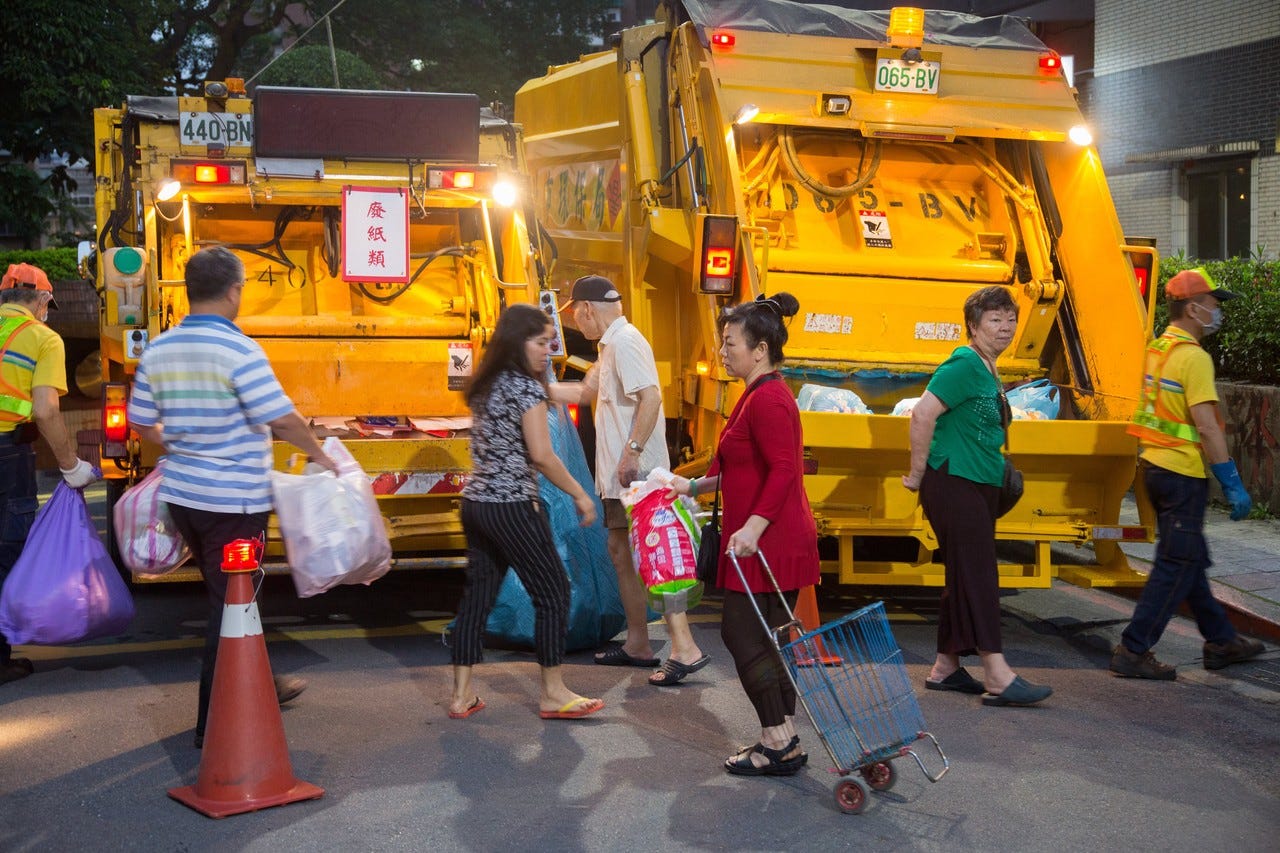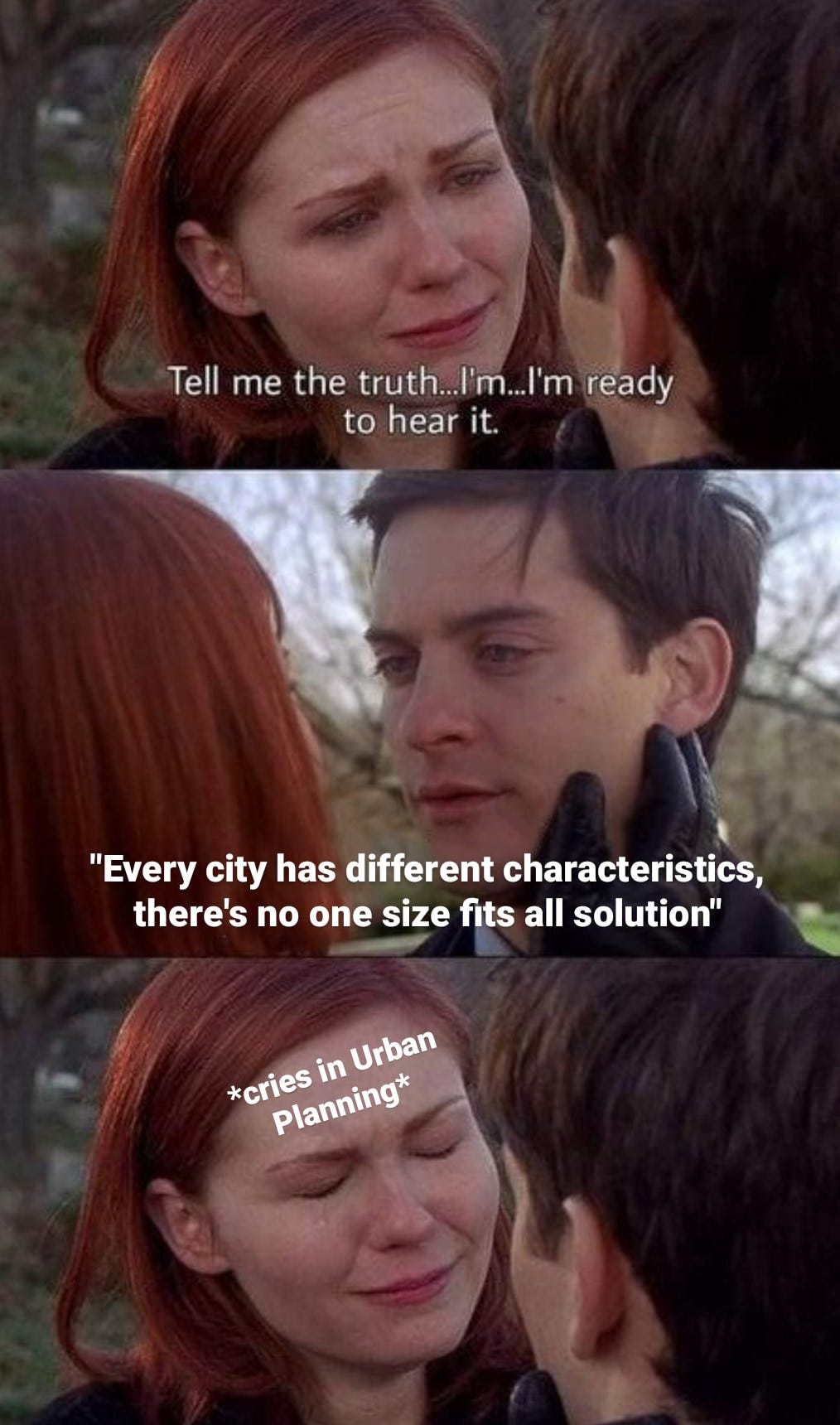Welcome to the very first edition of City Bits! Each issue we’ll look how different cities around the world are making life better for their residents. This week we’ll look at how Taipei, Taiwan, handles trash and recycling.
Today’s focus:
Residents of Taipei, and most other cities in Taiwan, don’t throw their trash in dumpsters. Nor do they leave garbage cans outside to be picked up. Instead, 5 days a week, 2-3 times a day, brightly colored trucks stop on their block, play Beethoven’s Fur Elise (or some other melody) and residents come outside to dispose of their garbage/recycling by hand. Garbage is thrown out in government approved bags (purchased at any local convenience store), while cans, bottles, plastics and other reusable materials can be sorted and disposed of for free, which incentivizes recycling.

Why it’s great:
Since introducing this system, the city of Taipei has seen a ~25% reduction in the annual amount of household waste generated, and boasts a household recycling rate of 67%1. Compared to other global cities like Amsterdam (27%)2,Singapore (52%)3 or New York City (18%)4, this puts Taipei in an elite group.
Landfill usage is down, as are the negative externalities that come from trash incineration, such as like air pollution, groundwater contamination etc.
Trash doesn’t pile up on the streets, and alleyways no longer need dumpsters, which allows more room for small vendors to set up shop, for households to park their bikes/scooters, or for the city to add urban greenery, parking spaces, etc.
How’d we get here:
First, a little background. Throughout the 1970s, 80s and 90s, Taiwan saw huge increases in quality of life and GDP per capita, as
The economy rapidly industrialized
The government ended a decades-long period of martial law
Citizens developed increasingly large and expensive consumer appetites.
Unfortunately, Taipei’s ability to manage the growing population did not scale accordingly, especially with regards to its waste disposal and recycling capabilities. From 1979 to 1992, total residential waste production jumped from 8,800 metric tons/year to almost 22,000/year, ~90% of which was being dumped straight into landfills. 5 By the mid 1990s, an island once dubbed “Ihla Formosa” (Beautiful Island) by early Portuguese settlers was now being called the less poetic but just as accurate “Garbage Island” by international journalists. 6
In response to the worsening smell, negative environmental effects, and health hazards from the incineration plants and overflowing landfills, in 1987 a group of Taipei housewives began to gather to discuss these issues. Fresh out of martial law, Taiwanese citizens were finally able to organize and voice dissent, and this small group of women would grow to form the basis of the Homemakers United Alliance, an organization that most trash historians 7 agree was instrumental in passing the landmark Waste Disposal Act of 1998. 8 This act would establish the basis of the effective waste disposal and recycling systems that Taiwan employs today.
Why it works: government support meets public demand
Credit is certainly due to the grassroots efforts organizers, but the government’s support is also a key factor in maintaining the system’s success. Once the public made it clear a change was needed, the Taiwanese EPA (in conjunction with the Taipei city government) supported this new system in 4 main ways
Logistics: The government began making sweeping changes to waste collection and recycling strategies, capabilities, and facilities. Thousands of pickup locations were organized, fleets of trucks were commissioned and hundreds of staff were hired and trained to ensure this new system could function. Public trash cans were also greatly reduced to incentivize truck usage and increase accountability, and publicity campaigns were undertaken to educate residents.
Offering Incentives: While the garbage bags cost a few cents, recycling was free, incentivizing households and businesses not only to recycle more, but also to better understand the system so they could maximize savings. 9 Similarly, in 2003 Taiwan also enacted a food waste program that allows for compost and other organic materials to be disposed of for free.
Punishments: The government also was strict with businesses or households caught flouting the rules, imposing fines and in some cases even publicly shaming offenders.
Funding: While the system partially pays for itself with revenue from the sale of the garbage bags, government subsidies are still highly necessary to ensure that this system keeps on running.10
Therefore, through direct funding of the system, creating the proper infrastructure, and employing both carrots and sticks to encourage adoption of the new system, the Taipei government’s support has been a key factor in its continued success.
Downsides:
Now I love this for Taipei, but the obvious downside is that it trades personal convenience11 for overall societal benefit. The trucks do stop at the same place and same time each day, but it can still be a hassle. When I lived in Taipei I didn’t mind taking my trash out, feeling good about helping the environment, and chatting up my neighborhood grannies at the truck stop. But I also didn’t have any small children at home, I had normal working hours, and I’m not physically disabled so it wasn’t difficult for me to walk downstairs each time. This isn’t the case for everybody, and even still I had times where I would miss the trucks and trash would pile up.
All this is just considering the ability, much less the willingness of the average citizen to participate. This brings us to our next section…
Barriers to implementation/why it might not work elsewhere:
I see three main areas that might make it challenging to implement this system in other cities: cultural attitudes, historical context, and the physical geography/density of the city itself.
Cultural attitudes:
At the risk of painting with a comically-large12 brush, Taiwanese culture probably plays a large role in the success of this system. In general, Taiwanese people tend to be more open to these sorts of collective sacrifices for the greater good. I’m generalizing here, but it’s hard to imagine folks lining up in Manhattan, or patiently queueing in Liverpool to throw their own garbage out into the back of a truck. I mean no disrespect to these cities, but for example, New York City legislators have been struggling with different agencies and mayoral candidates for over a decade on an initiative that would see residents separate out their organic waste without much real progress, 13 and that proposal asks significantly less of citizens than the Taipei model does.
Historical context:
Additionally, we already discussed the history of landfills and trash woes in Taipei, and this likely has an impact on the attitudes of Taipei residents. They had already seen how bad it could get and were determined to never go back, whereas other cities might not have reached such a breaking point.
Geography/density:
Taipei has the highest population density in Taiwan, which greatly helps this system’s implementation. A city like Nashville, US, which has a population density ~85% less than that of Taipei’s would require more routes, stops, trucks, etc. all of which drive up costs and complicate implementation. In fact, we can see this across the rest of Taiwan as well; while the city of Taipei has a recycling rate of 67%, the national average is only 55%,14 and this dips even lower when we look at less dense, more rural Taiwanese cities.15
In this newsletter I want to highlight cool ways that urban areas address their problems, but I in no way expect every solution to work in every city.
Conclusion:
Today we’ve looked at
Why I think this system is great
How Taipei got there
Why it’s still successful today.
We saw that recycling rates are up, per capita waste generation is down, the streets are cleaner, the alleyways don’t smell like rat ass, etc. We also understand that it took strong public demand and a supportive government to make this system work. Finally, we discussed how cultural attitudes, historical context and the density/geography of Taipei were critical to its success, and because of this not all other cities might be as willing/able to embrace it.
As I build out this newsletter, I’ve been struggling with what I want the “point” of these updates to be. Am I telling cities what to do? Am I just highlighting policies/initiatives that I think are interesting? I haven’t found a definitive answer to that yet, but my hope is that by understanding a city’s unique history, culture and characteristics we can at least understand why something works there, and hopefully apply that same analysis to other cities around the world. If nothing else, maybe this gives you a cool new fun fact to share with your friends. Either way, thanks for reading, and if you liked this please like, comment or subscribe16 to this newsletter for more updates!
-Max
https://www.wsj.com/amp/articles/taiwan-the-worlds-geniuses-of-garbage-disposal-1463519134
https://www.socialchallenges.eu/en-US/city/19/pitches/2487
https://www.nea.gov.sg/our-services/waste-management/waste-statistics-and-overall-recycling
https://www1.nyc.gov/assets/operations/downloads/pdf/mmr2019/dsny.pdf
https://www.bbc.com/future/article/20200526-how-taipei-became-an-unusually-clean-city
https://www.bbc.com/future/article/20200526-how-taipei-became-an-unusually-clean-city
By which I mean, historians who study trash, not historians who are bad at their job.
https://www.huf.org.tw/page/91
For example, understanding which days you can recycle cans, as opposed to plastic bottles sort of forces people to learn the system.
Side note: most of the more upscale apartment buildings will have collection services so residents don’t have to walk their trash out themselves, an employee will just lug huge carts out every night for a particular apartment.
And potentially racist?
https://www.politico.com/states/new-york/albany/story/2020/07/29/new-yorks-ambitious-compost-program-a-shell-of-its-former-self-1304088
Which still places it amongst the best countries in the world, but this an urban newsletter, not a country one.
Taipei also has a much higher budget than these cities, which certainly plays a part but isn’t necessarily tied to the density of the city, so for this section I’ve omitted that as a potential barrier to implementation, though of course money is always a consideration.
Absolutely hate that I need to say this phrase but I’m a slave to the algorithm now.





Fun fact: The athleisure company, Girlfriend Collective, sources all their recycled materials for their textiles in Taiwan because of the uniquely high standard Taiwan has with recycling :)
Recommend: https://youtu.be/0JtoSafhvLM